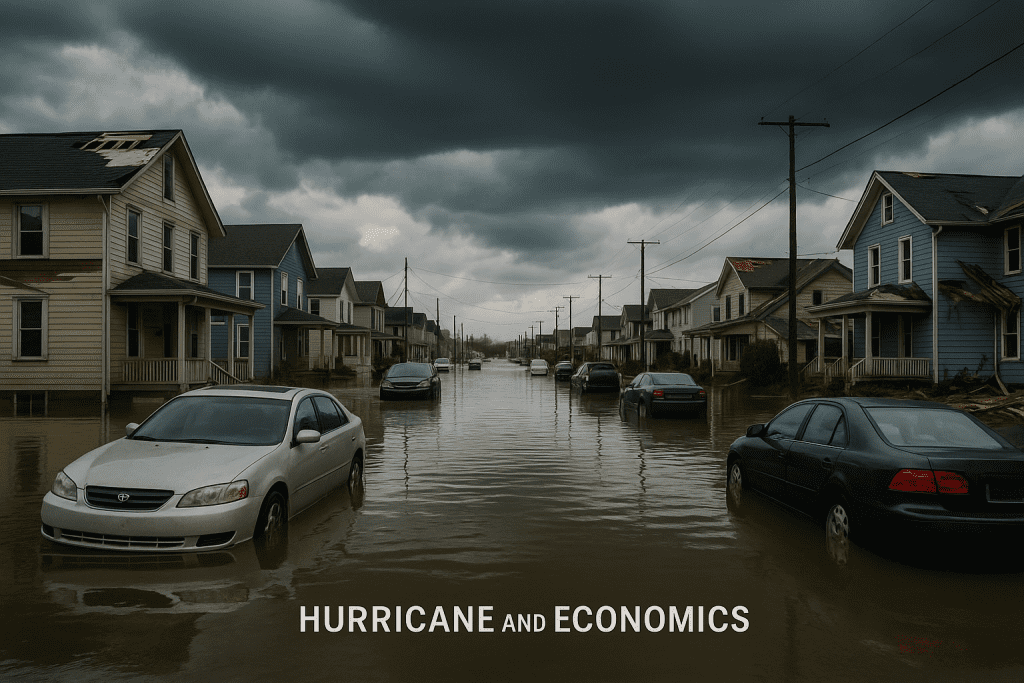A FinancePick Deep Dive

1) Introduction – When Natural Disasters Become an Economic Stress Test
A hurricane is not just a weather event—it is a systemic stress test for the economy. GDP, employment, inflation, fiscal spending, and insurance markets are all affected simultaneously. Economists are once again confronted with the age-old question known as the Broken Window Fallacy: can destruction actually generate growth?
2) Short-Term Impact – A Dual Shock to Supply and Demand
- Supply side: Ports and logistics infrastructure halt, causing import disruptions → commodity and food prices surge.
- Demand side: Household purchasing power shrinks; with utilities and housing disrupted, consumption contracts.
- Labor market: Mobility and workplace closures lead to short-term unemployment spikes. → Net effect: a negative GDP shock in the immediate aftermath.

3) Medium-Term Effects – Is Reconstruction Really Growth?
After a hurricane, both governments and the private sector generate massive reconstruction demand.
- GDP Illusion: Construction, retail, and materials may rebound sharply, boosting growth figures.
- The Reality: This spending is aimed at restoring destroyed assets—it does not create new net wealth.
- Broken Window Fallacy: As Bastiat explained, repairing a broken window doesn’t enrich society; the same applies here.
- Investment Opportunity: Some reconstruction leads to modernized infrastructure, which can enhance long-term productivity.
4) Fiscal and Financial Ripples
- Fiscal Policy: Disaster relief, insurance gaps, and infrastructure rebuilding → wider fiscal deficits.
- Monetary Policy: Central banks may remain accommodative if inflationary shocks are temporary, but spikes in fuel and food prices create policy dilemmas.
- Insurance & Reinsurance: Massive claims strain insurers’ solvency; reinsurance premiums rise, driving up long-term cost structures.
5) Regional Inequality and Social Consequences
- Low-Income Groups: Those without stable housing or insurance suffer disproportionately.
- Regional Disparities: Asset values drop and population outflows weaken long-term regional growth.
- Migration: Large-scale relocation pressures labor and housing markets elsewhere.
6) Global Spillovers of Hurricanes
- Commodities: U.S. Gulf refinery damage → short-term oil price spikes.
- Agriculture: Florida’s orange and sugar industries → global commodity price effects.
- Financial Markets: Hurricanes trigger risk-off sentiment, pushing demand for safe havens (U.S. Treasuries, USD, gold).
7) Climate Change as a Structural Variable
Research indicates that hurricanes are becoming stronger and more frequent.
- Insurance Model Stress: Coverage gaps widen as payouts soar.
- Government Spending: Climate adaptation projects (resilient infrastructure, green energy) absorb more fiscal resources.
- Corporate Costs: Firms must spend more on resilient supply chains and disaster preparedness.
8) Investor Takeaways
- Sector Positioning:
- Immediate aftermath: Insurance, agriculture negative.
- Mid-term: Construction, retail, materials benefit.
- Municipal Bonds: Hurricane-hit local governments may face rising risk premiums.
- ESG Angle: Firms with stronger climate resilience gain a long-term valuation premium.
- Hedging: Energy and agricultural ETFs can serve as short-term hedges.
9) Journalist’s Conclusion
Hurricanes deliver both immediate shocks and medium-term reconstruction boosts. But this is recovery, not genuine growth—confusing the two risks misinforming both policy and investment decisions.
The real lesson: climate risk is no longer cyclical but structural, embedded in economic systems. For investors, the winning strategy is not chasing temporary boosts but investing in long-term resilience.
